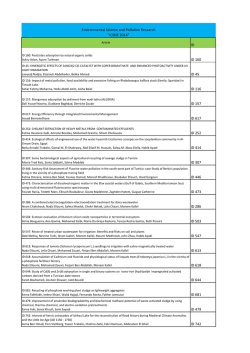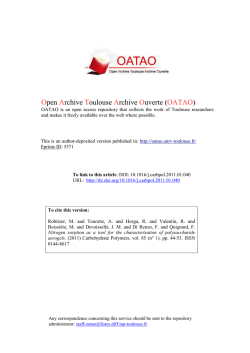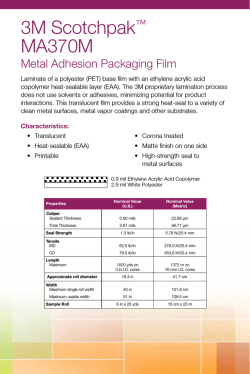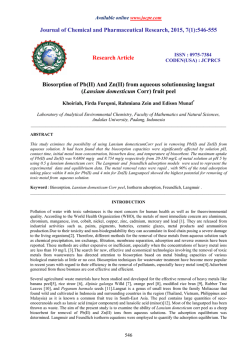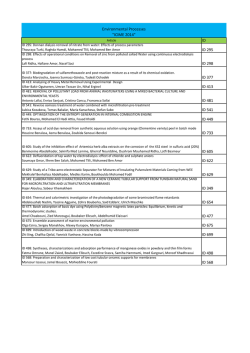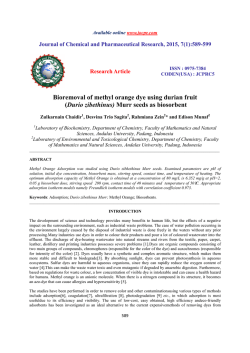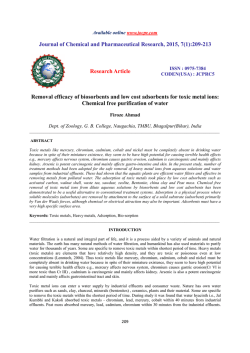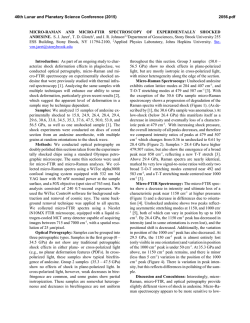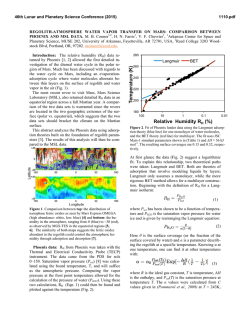
Adsorption studies on the removal of chromium onto chitosan-g
Available online www.jocpr.com Journal of Chemical and Pharmaceutical Research, 2015, 7(1):467-476 Research Article ISSN : 0975-7384 CODEN(USA) : JCPRC5 Adsorption studies on the removal of chromium onto chitosan-g-maliec anhydride-g-ethylene dimethacrylate M. R. Gopal Reddi1, C. Govindharajan1, P. N. Sudha2* and T. Gomathi2 1 Department of Chemistry, Bharathiar University, Coimbatore, Tamilnadu, India PG and Research Department of Chemistry, D. K. M College for Women, Vellore, Tamilnadu, India _____________________________________________________________________________________ 2 ABSTRACT In the present study the highly toxic metal chromium is removed using Chitosan-g-Maleic anhydride-g-ethylene dimethacrylate. The graft copolymer is synthesized through chain polymerization reaction using Ceric Ammonium Nitrate as the initiator. Graft copolymer was prepared by varying parameters such as monomer concentration, initiator concentration and temperature. The chemical structure and physical properties of prepared Chitosan-gMA-g-ethylene dimethacrylate copolymer were carried out by various analytical techniques such as Fourier transform resonance spectroscopy (FT-IR), and X-ray diffraction (XRD). Grafting was confirmed by FTIR. X-ray diffraction showed changes in crystalline pattern. Batch adsorption studies are carried out to find the adsorption efficiency of the material prepared by varying the parameters such as adsorbent dose, contact time, pH and initial concentration of the metal solution. The results are fitted with Langmuir and Freundlich isotherm models. Key words: Polymerization. Chitosan-g-MA, ethylene dimethacrylate, Grafting, Parameters. _____________________________________________________________________________________ INTRODUCTION Nowadays, enormous increase in the use of heavy metals has resulted in an increased flux of metallic substances in the aquatic system [1]. Untreated wastewater from industries constitute the major source of metal ion pollution in natural water [2]. Aquatic systems are exposed to a number of pollutants that are mainly discharged from tanneries, industries, sewage treatment plants and drainage from urban and agricultural areas causing damage to aquatic life [3]. Most of the heavy metal ions are toxic or carcinogenic posing a serious threat to human health and the environment [4]. The river systems may be excessively contaminated with heavy metals released from domestic, industrial, mining and agricultural effluents [5]. Chromium exists primarily in Cr (III) and Cr (VI) oxidation states. The later being hexavalent is considered as more toxic due to its higher solubility and mobility. These species are known to be associated with a spectrum of DNA lesions occurring during Cr (VI) exposure [6]. Chemical precipitation, filtration, membrane separation, ion exchange, oxidation/reduction, reverse osmosis, solvent extraction, chelating resins and adsorption are the various methods employed for the removal of heavy metal ions from waste water. Among these techniques adsorption is quite promising one. Recent developments have shown high removal efficiencies with much cheaper non-conventional materials which are mostly cheap and abundant biological matter [7-10]. Removal of heavy metals from solutions by biological materials is recognized as an extension to adsorption and is named as biosorption [11]. 467 P. N. Sudha et al J. Chem. Pharm. Res., 2015, 7(1):467-476 ______________________________________________________________________________ Chitosan, a biopolymer is a low cost adsorbent identified recently with an excellent physicochemical properties having the highest sorption capacity for the removal of heavy metal ions. Khor has stated that the 21st century can be the century of chitin and Chitosan taking a place as an extra-ordinary material because chitin and its derivatives have showed high potential in a wide variety of fields such as medical, pharmaceutical, cosmetics, food industry, agriculture, environmental protection [12-18]. Chitosan is chemically modified by graft copolymerization [19-22] which would enable a wide variety of molecular designs to afford tailored made hybrid materials composed of natural polysaccharides [23,24] and synthetic polymers[25,26]. Chitosan has two reactive groups namely free amino and hydroxyl groups that can be grafted effectively [27]. Two major types of grafting may be considered: 1. Grafting with single monomer and 2. Grafting with two monomers. The first type usually occurs in a single step and the second may occur with either the simultaneous (or) sequential use of the monomers [28]. In the present study, we have synthesized a novel type of material, namely Chitosan-gMaleic anhydride-g-(ethylene dimethacrylate) using ceric ammonium nitrate as the initiator. The prepared graft copolymer was subjected to various analytical techniques such as FTIR and XRD to confirm grafting. The graft copolymer prepared under optimum concentration was subjected in treating chromium contining aquesous solution to study it removal efficiency. EXPERIMENTAL SECTION Materials Chitosan was obtained from India sea foods Cochin, Kerala, India. The monomer maleic anhydride and ethylene dimethacrylate were of analytical grade and purchased from the company, Merck. All Other chemicals were of analytical grade and used as such. Preparation of Chitosan- g- Maleic anhydride Chitosan (2g) and maleic anhydride (5g) were dissolved in 100 ml of acetic acid and 10ml of ceric ammonium nitrate (0.5g) dissolved in10ml of Nitric is added. The mixture was stirred constantly at 70°C for 3hrs under nitrogen atmosphere. The resultant solution was cooled to room temperature and poured into 10% NaOH to precipitate the product. The product was filtered and washed with diethyl ether for several times and then dried in vacuum at 40°C. The grayish white powder of N-maleilated Chitosan was obtained. Preparation of Chitosan-g-Maleic anhydride-g-Ethylene Dimethacrylate The co-polymer was homogeneously synthesized in aqueous solution using Ceric ammonium nitrate as the initiator. A mixture of 0.5 g maleilated chitosan was dissolved in150 ml formic acid followed by the addition of ethylene dimethacrylate (2g) dissolved in ethanol. The reaction was carried out at 70 °C for about 30 minutes. The contents of the flask were cooled to room temperature and poured into 10% NaOH solution to precipitate the graft copolymer. The parameters such as initiator concentration, monomer concentration and reaction temperature and the grafting yield and efficiency were investigated. FTIR Spectroscopy FTIR spectra of the grafted co-polymer was determined by Perkin Elmer spectrophotometer and in a wide range wavelength between 400 cm-1 to 4000 cm-1 and in solid state using KBr pellet method. X – Ray Diffraction X – Ray diffraction patterns of ungrafted and grafted chitosan were obtained with a D\max - 2200 X ray diffractometer using graphite-monochromatized Cu Kα radiation (Kα = 1.54178 (Å) Preparation of stock solution Cr(IV) stock solution was prepared to get a concentration of 200mg/L of chromium as potassium dichromate. 1:1 Hydrochloric acid and 2N sodium hydroxide solutions were used for pH adjustment. The exact concentration of each metal ion solution was calculated on mass basis and expressed in terms of mg L-1. The stock solution was further diluted to the required concentrations. All precautions were taken to minimize the loss due to evaporation during the preparation of solutions and subsequent measurements. The stock solutions were prepared fresh for each experiment as the concentration of the stock solution may change on long standing. 468 P. N. Sudha et al J. Chem. Pharm. Res., 2015, 7(1):467-476 ______________________________________________________________________________ Batch adsorption studies Batch studies were performed with different concentrations of potassium dichromate to investigate the extent of adsorption using Chitosan-g-Maleic anhydride-g-(Ethylene dimethacrylate). Synthetic solution of Cr(VI) ion taken in stoppered bottles and agitated with the blend films at 30 °C in orbit shaker at fixed speed of 210rpm. The extent of heavy metal removal was investigated separately by changing adsorption dose, contact time, initial concentration and changing pH of the solution. After attaining the equilibrium adsorbent was separated by filtration using filter paper and aqueous phase concentration of metal was determined with atomic adsorption spectrophotometer (Varian AAA 220FS). RESULTS AND DISCUSSION FTIR studies FTIR spectrum of pure chitosan, chitosan-g-maleic anhydride and Chitosan-g-Maleic anhydride-g-(Ethylene dimethacrylate) copolymer are shown in Figure 1a – 1c. FTIR spectrum of pure chitosan (figure.1a) shows a broad peak around 3454 cm-1 due to -NH stretching and -OH stretching and the peaks around 1628 cm-1 and 1540 cm-1 due to amide I and amide II groups. The characteristic C-O stretching vibration appears at 1098 cm-1 and the C-N stretching vibration at 1485 cm-1. The aliphatic (-CH2) stretching vibration shows a peak at 2923 cm-1. FTIR spectrum of Chitosan-g-Maleic anhydride is shown in Figure 1b. The new strong band present at 1596 cm-1 indicates C=C bond, confirming the grafting of malefic anhydride group onto chitosan. The νas (COO−) band is observed at around 1643 cm−1 whileνsym (COO−) is observed at 1415 cm−1. 88 86 84 472.23 82 80 66 64 62 776.38 1021.37 68 1151.84 1098.72 1540.02 1628.87 70 3454.75 %T 72 1421.52 1384.01 1322.23 2923.08 74 1740.23 76 674.35 78 60 58 56 54 52 50 3500 3000 2500 2000 Wavenumbers (cm-1) Figure 1a: FTIR spectrum of chitosan 469 1500 1000 500 P. N. Sudha et al J. Chem. Pharm. Res., 2015, 7(1):467-476 ______________________________________________________________________________ . Figure 1b: FTIR spectrum of chitosan-g-Maleic anhydride Figure 1c: FTIR spectrum of Chitosan-g-Maleic anhydride-g-(Ethylene dimethacrylate) Chitosan-g-Maleic anhydride-g-(Ethylene dimethacrylate) copolymer was formed when maleilated chitosan was grafted with ethylene dimethacrylate. The FTIR spectrum (Figure 1c) of Chitosan-g-Maleic anhydride-g-(Ethylene dimethacrylate) copolymer had additional vibration bands at 1643 cm-1 and 1387 cm-1 due to carbonyl stretching. The symmetrical and asymmetrical peaks of the aliphatic groups (-CH3, -CH2) are obtained around 2826cm-1 and 2898 cm-1. The characteristic ester (-C-O-C-) vibration band appears at region 1267 cm-1 - 1155 cm-1. The formation of the new peaks and the shift in peak position in the spectrum confirms the formation of the graft copolymer chitosan-g-maleic anhydride-g-(Ethylene dimethacrylate). 470 P. N. Sudha et al J. Chem. Pharm. Res., 2015, 7(1):467-476 ______________________________________________________________________________ X-ray diffraction studies The X-ray diffraction spectra of pure chitosan and chitosan -g- maleic anhydride were meseasured. The XRD pattern of chitosan (Figure 2a) has low crystallinity and the characteristic peaks at 2θ = 11º and 20º. The chitosan-g-Maleic anhydride (Figure 2b) shows the values at 2θ = 18º, 24º, 26º and 30º. The maleilated chitosan-g-(Ethelene dimethacrylate) (Figure 2c) does not have the peak at 2θ = 11º, 18º, 24º, 26º and 30º. Hence crystallanity of the grafted copolymer decreased much when compared with pure chitosan and CS-g-MA. Figure 2a: XRD of Chitosan Figure 2b: XRD of CS-g-MA Figure 2c: XRD of chitosan-g-maleic anhydride-g-(Ethylene dimethacrylate) Factors influencing the adsorption of Cr (VI) ions The influences of several operational parameters like dose of adsorbent, pH, initial metal ion concentration and contact time on the adsorption process were investigated through batch mode. The results are discussed below. Effect of adsorbent dose Figure 3 shows the adsorption of chromium ions onto the chitosan-g-maleic anhydride-g-ethylene dimethacrylate copolymer (adsorbent). The experiment was carried out by taking various adsorbent concentrations ranging from 1g to 6g separately keeping the other variables (pH and contact time) constant. It was observed that the percentage removal of Cr6+ ions increases gradually with the increase of adsorbent dosage, this may be due to the fact that more surface area is available for adsorption process. The maximum percentage removal of Cr(VI) was about 86.9% at the dosage of 6 g. This was attributed to the fact that after a certain dose of adsorbent the maximum adsorption sets in and so the minimum surface area is available for further metal ion adsorption. Hence the amount of ions bound to the adsorbent and the amount of free ions in the solution remains constant even after the adsorbent dose is increased. 471 P. N. Sudha et al J. Chem. Pharm. Res., 2015, 7(1):467-476 ______________________________________________________________________________ Figure 3: Effect of adsorbent dose on the removal of Cr6+ ions Effect of contact time Figure 4 shows the effect of contact time on the adsorption of Cr6+ ions onto the graft copolymer. Initially rate of removal of Cr6+ ions was found to be higher as soon as the metal ions and graft copolymer came into contact.This was due to the larger surface area being available at the beginning for the adsorption of Cr6+ ions [29]. Further increase in contact time shows a decrease in the uptake of metal ions which may be due to the decrease in the number of available active sites for adsorption till the equilibrium is reached. The results indicate that the rate of removal of metal ions was increased with an increase in the contact time up to 360 mins and remained constant (86.1%) .Thus the optimum contact time for the maximum removal (86.1%) was 360 mins indicating that it is one of the important parameters for an economical waste water treatment. Figure 4: Effect of contact time Effect of pH The pH of the solution affects on the surface charge of the adsorbent. A small change in pH influences both the adsorbent surface as well as inonic species of metal ion in water. At different pH values, the protonation and deprotonation behaviours of acidic and basic groups would be influenced [30]. Figure 5 shows that the adsorption increases slowly with an increase in pH of the metal ion solution and then it decreases gradually. The maximum 472 P. N. Sudha et al J. Chem. Pharm. Res., 2015, 7(1):467-476 ______________________________________________________________________________ percentage removal of Cr(VI) was about 87.2% at pH 5.5. This is due to the decrease in competition between the proton and metal ions for the same functional groups and by the decrease in positive surface charge on the adsorbent resulting in a lower electrostatic repulsion between surface and metal ions. Decrease in adsorption at higher pH value was due to the formation of soluble hydroxyl complexes [31] Figure 5: Effect of pH Adsorption isotherms The isotherm models explain the relationship between the adsorbed metal ion concentration and concentration of the solution at equilibrium. For adsorption studies Langmuir and Freundlich equations are widely used. Langmuir sorption isotherm. Langmuir model explains monolayer adsorption on an energetically uniform surface on which there is no interaction between the adsorbed molecules. [32,33]. Equilibrium is attained once the monolayer formation is completely saturated [34]. It was assumed that every sorption site is equivalent and the ability of sorbate to get bound there is independent of whether (or) not the neighboring sites are occupied [35]. The pH value of optimum adsorption is (pH = 5.5) and with the necessary contact time to reach the adsorption equilibrium of the metal ion. The Langmuir model is given as follows, Ceq/Cads = bCeq/KL + 1/KL (1) Cmax = KL/b (2) where Cads = amount of metal ions adsorbed (mg g-1) Ceq = equilibrium concentration of metal ion in solution (mg dm-3) KL = Langmuir constant (dm3.g-1) b = Langmuir constant (dm3.g-1) Cmax = maximum metal ion to adsorb onto 1g adsorbent (mg.g-1) The constant “b” in the Langmuir equation is related to the energy or the net enthalpy of the sorption process. The constant KL can be used to determine the enthalpy of adsorption [29]. The constants “b” and “KL” are the characteristics of the Langmuir equation and can be determined from the linearised form of the Langmuir equation . 473 P. N. Sudha et al J. Chem. Pharm. Res., 2015, 7(1):467-476 ______________________________________________________________________________ Fig 6 : Langmuir isotherm for Chromium (VI) Table 1. Adsorption isotherm constant, Cmax and correlation coefficient Langmuir constants Metal ion KL (dm3.g-1) b (dm3.mg-1) Cmax (mg.g-1) R2 Cr6+ 0.6684 0.004725 141.46 0.7032 The Langmuir equation was used to explain the data obtained from the adsorption of Cr (VI) ions by graft copolymer adsorbent over the entire concentration range. A plot of Ceq/Cads against Ceq gives a straight line (Fig 6). The results of the adsorption isotherm in Table 1 shows a good correlation by the graft copolymer. The Cmax value is 141.46 mg of Cr per gram of copolymer. Value of R2 shows correlation or linear relationship. The essential features of a Langmuir isotherm can be expressed in terms of a dimensionless constant separation factor or equilibrium parameter, RL that is used to predict if an adsorption system is favourable or unfavourable. The separation factor, RL is defined by RL = 1/1+bCf where Cf is the final Cr(VI) concentration (mg dm-3) and b is the Langmuir adsorption equilibrium constant (dm3mg1 ). The parameter indicates the isotherm shape according to Table 2 Table 2. RL values based on Langmuir adsorption Metal ions Cr (VI) Initial concentration C0 (mg.dm-3) 1000 500 200 100 50 Final concentration Cf (mg.dm-3) 772 384 194 95 46 RL Values 0.2151 0.3553 0.5217 0.6902 0.8214 The values of RL calculated for Cr(IV) concentration is given in Table 1. Adsorption of Cr(IV) onto chitosan-gmaleicanhydride-g–ethylene dimethacrylate is favourable as the values are in the range of 0<RL<1 indicating the graft copolymer is an efficient adsorbent. Freundlich isotherm The Freundlich isotherm equation is used for the description of multilayer adsorption with the interaction between adsorbed molecules. The model predicts that the adsorbate concentration in the solution will be increasing. The 474 P. N. Sudha et al J. Chem. Pharm. Res., 2015, 7(1):467-476 ______________________________________________________________________________ model applies to the adsorption onto heterogeneous surfaces with uniform energy distribution and reversible adsorption. The non-linear form of Freundlich equation may be written as qe = Kf Ce1/n (3) The linearised form of Freundlich isotherm is given by the equation log qe =log Kf+ 1/n log Ce (4) Ce = Equilibrium concentration of adsorbate in solution after adsorption (mg dm3) Kf = Emprical Freundlich constant or capacity factor (mg g-1) 1/n = Freundlich exponent Non-linear behaviour of adsorption indicates that adsorption energy barrier increase exponentially with increasing fraction of filled sites on the adsorbent . Fig 7: Freundlich isotherm for Chromium (VI) Kf and n are Freundlich constants. Kf indicates the relative sorption capacity and n is the measure of the nature and strength of the sorption process and the distribution of active sites. Fig.7 corresponds to the isotherm of chromium (VI). Mathematical calculations showed that n values are between 1 and 10 representing beneficial sorption [36]. Table 3. Freundlich isotherm parameters for Cr (VI) on graft copolymer Metal ion Cr6+ Freundlich parameters Kf (mg.g-1) n R2 0.6931 3.5373 0.9024 The Freundlich parameter 1/n is the adsorption intensity of metal ions on biosorbent. The Freundlich constants Kf and n are 0.6931 and 3.5373 (Table 3). Other than homogeneous surface, the Freundlich equation is also suitable for a highly .heterogeneous surface and an adsorption isotherm shows the formation multilayer adsorption. The value of 1/n is less than unity indicating the significant adsorption at low concentration. In the present study CS-g-MAg-EDMA was used as an adsorbent. The “n” value lies between 1 and 10 which represents beneficial adsorption. CONCLUSION Chitosan-g-MA-g-ethylene dimethacrylate was synthesized through graft co-polymerization in aqueous solution using ceric ammonium nitrate as initiator. FTIR spectroscopy confirmed the introduction of ethylene dimethacrylate side chain onto the N- maleilated chitosan backbone by graft co-polymerization. The effect of adsorbent dosage, contact time and pH of the medium on adsorption efficiency of graft co-polymer were studied to find the optium removal of metal ion. According to regression coefficient the Freundlich adsorption isotherm was better fitted than 475 P. N. Sudha et al J. Chem. Pharm. Res., 2015, 7(1):467-476 ______________________________________________________________________________ the Langmuir. Hence the graft co-polymer Chitosan -g -MA- g-ethylene dimethacrylate act as a good adsorbent and can be used for wastewater treatment . REFERENCES [1] H Yang; NL Rose. Distribution of Hg in the lake sediments across the UK. Sci. Total Environ., 2003, 391–404. [2] DR Livingstone, Mar. Pollut. Bull., 2001, 42(2), 656–666. [3] R Karbassi; I Bayati; F Moattar, Int. J. Environ. Sci. Tech., 2006, 3(1), 35–42. [4] C Damien; VH Chantal; S Pirouz; FH Zerimech; J Laurence; MH Jean, Water, Air, Soil Pollut., 2004, 152(1), 55– 69. [5] OR Vander; J Beyer; NPE Verneykebm, Toxicol. Pharmacol., 2003, 13(2) 57 – 149. [6] M Reynolds; E Peterson; G Quievryn; A Zhitkovich, J. Biol. Chem., 2004, 279(29), 30419–30424. [7] D Mohan; CU Pittman, Hazard. Mater., 2006, 137(2), 762-811. [8] SM Nomanbhay; K Palanisamy, Elect. J.Biotechnol., 2005, 8(1), 43-53. [9] S Babel; TA Kurniawan, J. Hazard. Mater., 2003, 97(1-3), 219-243. [10] Z AnsarAli; V Jeyachandran, Int. J. Environ. Sci., 2011, 1(5), 820-833. [11] V Boddu; K Abburi; JL Talbott; ED Smith, Environ. Sci. Technol., 2003, 37(19), 4449-4456. [12] E Khor, Curr. Opin. Solid State. Mater. Sci., 2002, 6(4), 313 – 317. [13] D Van Luyen, DM Huong. Chitin and Derivatives in Polymeric Materials encyclopedia.1996; Salamone J.C. (Eds), CRC, Boca Raton (Florida), 1208-1217. [14] HS Kas, J. Microencapsulation., 1997, 14(6), 689 – 711. [15] K Kurita; T Kojima; T Munakata; H Akao; T Mori; Y Nishiyama, Chem. Lett., 1998, 27(4), 317–318. [16] MG. Peter. Chitin and chitosan from animal sources in Biopolymers, (Polysaccharides II).2002; S De Baets; EJ Vandamme; A Steinbuchel. (Eds) Wiley – VCH, Weinheim, 2, ch. 15. [17] S Hirano, Polym. Int., 1999, 48(8), 732 -734. [18] MNV Ravikumar, React. Funct. Polym., 2000, 46(1), 1-27. [19] H Caner; H Hasipoglu; O Yilmaaz; E Yilmaaz, Eur. Polym.J., 1998, 34(3-4), 493-497. [20] MY Pedram, J. Retuert. J.Appl. Polym. Sci., 1997, 63(10), 1321-1326. [21] KL Shantha; U Bala; KP Rao, Eur. Polym. J., 1995, 31(4), 377. [22] TW Sun; P Xu, Carbohydr. Polym., 2004, 58(4), 379-382. [23] A Srivastava; J Tripathy; M Mishra; K Behari, J. Appl. Polym. Sci., 2007, 106(2), 1353-1358. [24] J Tripathy; D.K Mishra; MM Mishra; K Behari, Carbohydr. Polym., 2008, 72, 462. [25] S Yoshikawa; T Takayama; N Tsubokawa, J. Appl. Polym. Sci., 1998, 68(11), 1883–1889. [26] MY Pedram; A Lagos; J Retuert; R Guerrero; P Riquelme, J. Macromol Sci., Pure Appl. Chem, 1995, 32 (5), 1037–1047. [27] NM Alves; JF Mano, Int. J. Biolo. macromol., 2008, 43(5) 401-414. [28] A Bhattacharya; BN Misra, Progr. Polym. Sci., 2004, 29(8), 767-814. [29] A Shafaghat; F Salimi; MVJ Salehzadeh; M Shafagha, Afr. J.Biotech., 2012, 11(4), 852-855. [30] MM El-Toony; M Abdel-Geleei; RO Aly; HF Ali, Nat. Sci., 2011,9(2). [31] AK Meena; GK Mishra; S Kumar; C Rajagopal; PN Nagar, Adsorption of Ni(II) and Zn(II) fom aqueous solution by chemically treated activated carbon, National Conference on Carbon,DMSRDE,Kanpur., 2013. [32] P Baroni; RS Vieira; E Meneghetti; MGC Da Silva; MM Beppu, J. Hazard. Mater., 2008, 152(3),1155-1163. [33] TS Singh; KK Pant, Sep.Purif.Technol., 2004, 36(2), 139-147. [34] SP Dubey; K Gopal, J. Hazard. Mater., 2007, 145(3), 465-470. [35] I Langmuir, J. Am. Chem. Soc., 1918, 40(9), 1361–1403. [36] J Febrinto; AN Kosasih; J Sunarso; Yi-H Jua, N Indraswati; S Ismadiji, J. Hazard. Mater., 2009, 162(2-3), 616645. 476
© Copyright 2025
